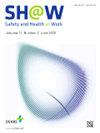企业特点与遵守旨在改善丹麦职业安全和健康的基于对话的检查实践有关
IF 2.9
3区 医学
Q1 PUBLIC, ENVIRONMENTAL & OCCUPATIONAL HEALTH
引用次数: 0
摘要
社会心理和人体工程学工作环境中的风险对劳动检查员来说可能是复杂和难以发现的。2020年,当局实施了基于对话的检查实践,以改善所有类型丹麦企业的工作环境。方法研究样本由3183家企业组成,源于丹麦当局在全国范围内实施的准实验——问题解决协议(ATP)。如果劳动监察员怀疑存在复杂的健康和安全问题,特别是在社会心理或人体工程学工作环境方面的问题,向提供ATP的企业可以接受这一自愿协议。我们使用单变量和多变量逻辑回归模型来研究企业特征与ATP实现之间的关系。结果2020 - 2023年,共有2335家企业完成了ATP。与公共管理、教育和卫生保健行业相比,工业、原材料和供应、贸易、运输等行业履行协议的优势比(OR)显著降低[OR: 0.70, 95%可信区间(CI): 0.53;0.92和OR: 0.6, 95% CI: 0.46;分别为0.80)。员工人数超过35人的企业履行协议的概率显著高于员工人数为1-9人的企业。人体工程学方面的满意度OR是心理社会方面的0.75倍(95% CI: 0.58; 0.98)。这种基于对话的检查实践在解决和消除对社会心理和人体工程学工作环境的怀疑方面显示了有希望的结果。企业的行业、雇员人数以及职业安全和健康问题的类型与这种基于对话的检查实践的实施有关。本文章由计算机程序翻译,如有差异,请以英文原文为准。
Enterprise Characteristics Were Associated With Adherence to a Dialog-based Inspection Practice Aimed at Improving Occupational Safety and Health in Denmark
Background
Risks in the psychosocial and ergonomic working environment can be complex and difficult for labor inspectors to uncover. In 2020, authorities implemented a dialog-based inspection practice in order to improve the working environment in all types of Danish enterprises.
Methods
The study sample consisted of 3183 enterprises and stemmed from a quasi-experiment, Agreement To Problem-solve (ATP), implemented nation-wide by Danish authorities. Enterprises that were offered an ATP could accept this voluntary agreement if the labor inspectors suspected a complex health and safety problem, especially problems in the psychosocial or ergonomic working environment. We used univariate and multivariate logistic regression models to investigate associations between enterprise characteristics and fulfillment of the ATP.
Results
In total, 2335 enterprises fulfilled an ATP from 2020 to 2023. Compared to Public administration, education and health care, the industries Industrial, raw materials and supply and Trade, transportation etc. had significantly lower odds ratios (ORs) of fulfilling the agreement [OR: 0.70, 95% confidence interval (CI): 0.53; 0.92 and OR: 0.6, 95% CI: 0.46; 0.80, respectively]. Enterprises with more than 35 employees had a significantly higher probability of fulfilling the agreement than enterprises with 1–9 employees. The OR of fulfillment regarding ergonomics was 0.75 times that of the psychosocial (95% CI: 0.58; 0.98).
Conclusion
This dialog-based inspection practice showed promising results in regards to addressing and terminating suspicions regarding the psychosocial and ergonomic working environment. The enterprises' industry, number of employees, and type of occupation safety and health problem were associated with fulfillment of this dialog-based inspection practice.
求助全文
通过发布文献求助,成功后即可免费获取论文全文。
去求助
来源期刊

Safety and Health at Work
Social Sciences-Safety Research
CiteScore
6.40
自引率
5.70%
发文量
1080
审稿时长
38 days
期刊介绍:
Safety and Health at Work (SH@W) is an international, peer-reviewed, interdisciplinary journal published quarterly in English beginning in 2010. The journal is aimed at providing grounds for the exchange of ideas and data developed through research experience in the broad field of occupational health and safety. Articles may deal with scientific research to improve workers'' health and safety by eliminating occupational accidents and diseases, pursuing a better working life, and creating a safe and comfortable working environment. The journal focuses primarily on original articles across the whole scope of occupational health and safety, but also welcomes up-to-date review papers and short communications and commentaries on urgent issues and case studies on unique epidemiological survey, methods of accident investigation, and analysis. High priority will be given to articles on occupational epidemiology, medicine, hygiene, toxicology, nursing and health services, work safety, ergonomics, work organization, engineering of safety (mechanical, electrical, chemical, and construction), safety management and policy, and studies related to economic evaluation and its social policy and organizational aspects. Its abbreviated title is Saf Health Work.
 求助内容:
求助内容: 应助结果提醒方式:
应助结果提醒方式:


